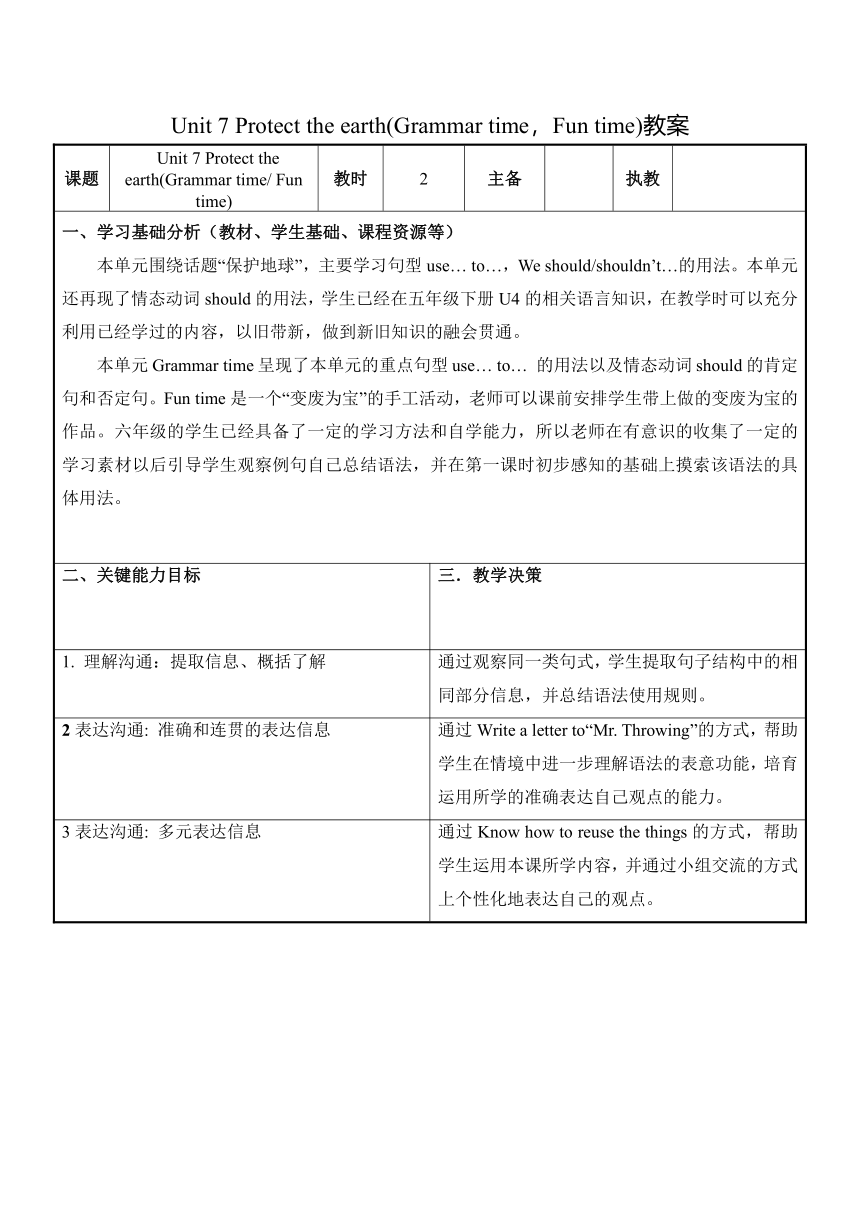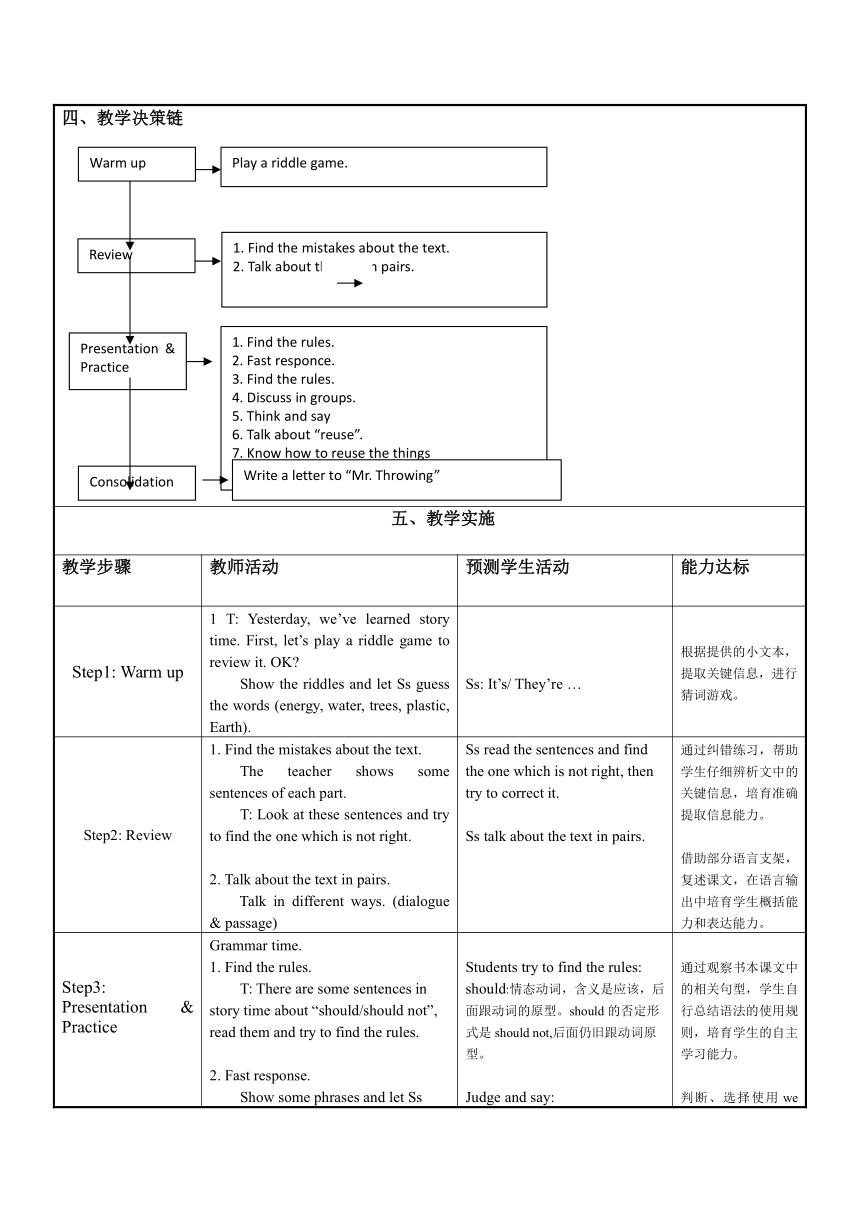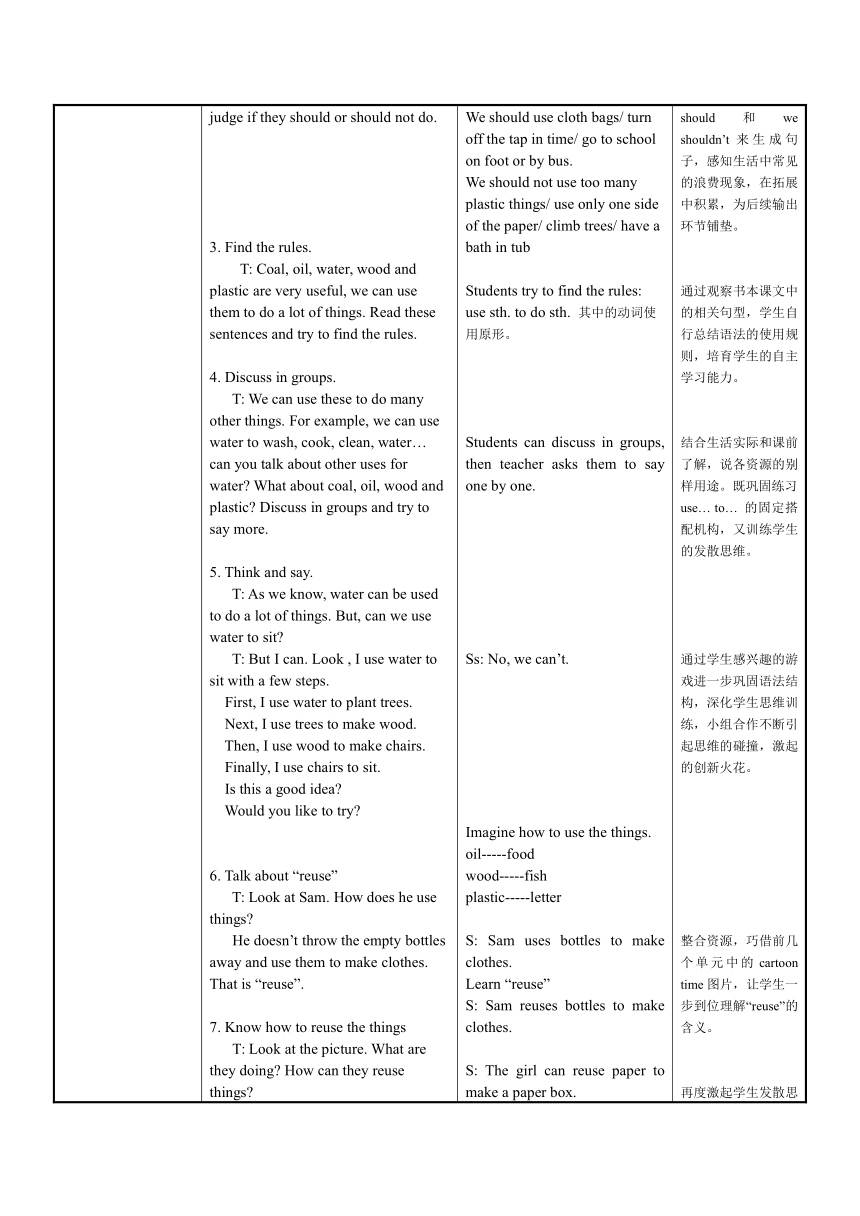Unit 7 Protect the earth(Grammar time,Fun time)表格式教案
文档属性
| 名称 | Unit 7 Protect the earth(Grammar time,Fun time)表格式教案 |  | |
| 格式 | docx | ||
| 文件大小 | 108.2KB | ||
| 资源类型 | 教案 | ||
| 版本资源 | 牛津译林版 | ||
| 科目 | 英语 | ||
| 更新时间 | 2021-12-18 20:48:37 | ||
图片预览



文档简介
Unit 7 Protect the earth(Grammar time,Fun time)教案
课题 Unit 7 Protect the earth(Grammar time/ Fun time) 教时 2 主备 执教
学习基础分析(教材、学生基础、课程资源等) 本单元围绕话题“保护地球”,主要学习句型use… to…,We should/shouldn’t…的用法。本单元还再现了情态动词should的用法,学生已经在五年级下册U4的相关语言知识,在教学时可以充分利用已经学过的内容,以旧带新,做到新旧知识的融会贯通。 本单元Grammar time呈现了本单元的重点句型use… to… 的用法以及情态动词should的肯定句和否定句。Fun time是一个“变废为宝”的手工活动,老师可以课前安排学生带上做的变废为宝的作品。六年级的学生已经具备了一定的学习方法和自学能力,所以老师在有意识的收集了一定的学习素材以后引导学生观察例句自己总结语法,并在第一课时初步感知的基础上摸索该语法的具体用法。
二、关键能力目标 三.教学决策
1. 理解沟通:提取信息、概括了解 通过观察同一类句式,学生提取句子结构中的相同部分信息,并总结语法使用规则。
2表达沟通: 准确和连贯的表达信息 通过Write a letter to“Mr. Throwing”的方式,帮助学生在情境中进一步理解语法的表意功能,培育运用所学的准确表达自己观点的能力。
3表达沟通: 多元表达信息 通过Know how to reuse the things的方式,帮助学生运用本课所学内容,并通过小组交流的方式上个性化地表达自己的观点。
四、教学决策链
五、教学实施
教学步骤 教师活动 预测学生活动 能力达标
Step1: Warm up 1 T: Yesterday, we’ve learned story time. First, let’s play a riddle game to review it. OK Show the riddles and let Ss guess the words (energy, water, trees, plastic, Earth). Ss: It’s/ They’re … 根据提供的小文本,提取关键信息,进行猜词游戏。
Step2: Review 1. Find the mistakes about the text. The teacher shows some sentences of each part. T: Look at these sentences and try to find the one which is not right. 2. Talk about the text in pairs. Talk in different ways. (dialogue & passage) Ss read the sentences and find the one which is not right, then try to correct it. Ss talk about the text in pairs. 通过纠错练习,帮助学生仔细辨析文中的关键信息,培育准确提取信息能力。 借助部分语言支架,复述课文,在语言输出中培育学生概括能力和表达能力。
Step3: Presentation & Practice Grammar time. 1. Find the rules. T: There are some sentences in story time about “should/should not”, read them and try to find the rules. 2. Fast response. Show some phrases and let Ss judge if they should or should not do. 3. Find the rules. T: Coal, oil, water, wood and plastic are very useful, we can use them to do a lot of things. Read these sentences and try to find the rules. 4. Discuss in groups. T: We can use these to do many other things. For example, we can use water to wash, cook, clean, water… can you talk about other uses for water What about coal, oil, wood and plastic Discuss in groups and try to say more. 5. Think and say. T: As we know, water can be used to do a lot of things. But, can we use water to sit T: But I can. Look , I use water to sit with a few steps. First, I use water to plant trees. Next, I use trees to make wood. Then, I use wood to make chairs. Finally, I use chairs to sit. Is this a good idea Would you like to try 6. Talk about “reuse” T: Look at Sam. How does he use things He doesn’t throw the empty bottles away and use them to make clothes. That is “reuse”. 7. Know how to reuse the things T: Look at the picture. What are they doing How can they reuse things In our life, we can reuse a lot of things, for example, …,right Look, I can reuse a plastic bottle to make a pen holder or a vase. Do you have any good ideas Share with us. T: You all have great ideas. Boys and girls, if we reuse paper, we can save trees, if we reuse water, we can save water. So we can say “Reusing is saving”. Do you think so Students try to find the rules: should:情态动词,含义是应该,后面跟动词的原型。should的否定形式是should not,后面仍旧跟动词原型。 Judge and say: We should use cloth bags/ turn off the tap in time/ go to school on foot or by bus. We should not use too many plastic things/ use only one side of the paper/ climb trees/ have a bath in tub Students try to find the rules: use sth. to do sth. 其中的动词使用原形。 Students can discuss in groups, then teacher asks them to say one by one. Ss: No, we can’t. Imagine how to use the things. oil-----food wood-----fish plastic-----letter S: Sam uses bottles to make clothes. Learn “reuse” S: Sam reuses bottles to make clothes. S: The girl can reuse paper to make a paper box. The boy can reuse a plastic bottle to make a toy. S: I can reuse __________ to make __________ . Read: Reusing is saving. 通过观察书本课文中的相关句型,学生自行总结语法的使用规则,培育学生的自主学习能力。 判断、选择使用we should和we shouldn’t来生成句子,感知生活中常见的浪费现象,在拓展中积累,为后续输出环节铺垫。 通过观察书本课文中的相关句型,学生自行总结语法的使用规则,培育学生的自主学习能力。 结合生活实际和课前了解,说各资源的别样用途。既巩固练习use… to… 的固定搭配机构,又训练学生的发散思维。 通过学生感兴趣的游戏进一步巩固语法结构,深化学生思维训练,小组合作不断引起思维的碰撞,激起的创新火花。 整合资源,巧借前几个单元中的cartoon time图片,让学生一步到位理解“reuse”的含义。 再度激起学生发散思考问题,联系生活实际,将语言实践与创新意识紧密结合。
Step4: Consolidation 1. Read about “Mr. Throwing” T: But in our life, some people don’t care about “saving”. Look, this is Mr. Wang. But people don’t like to call him Mr. Wang. They like to call him Mr. Throwing. Do you know why Let’s read a story about him. After that, tell me the answer, OK 2. Tick “What does Mr. Throwing like to throw ” 3.Give suggestions I think Mr. Throwing has some bad habits. Can you give him some suggestions These key sentences and useful words may help you. 4. Write a letter to Mr. Throwing. T: Your ideas are very helpful. Why don’t we write a letter to Mr. Throwing and share with him our great ideas Come on. Let’s do it! Look, to write this letter, first, we should tell him ---. Next, we should tell him---. And finally, we should--- Yes, we should call him to reuse, to save, to protect the Earth with us, right Now talk in groups and discuss the passage. T: Good children. with our suggestions, I am sure Mr. Throwing won’t throw so many things and people won’t call him Mr. Throwing again. Do you think so Read the passage about Mr. Wang and try to understand why he is called Mr. Throwing. S: Don’t …/ You shouldn’t… Please…/ You should … S: ---why we should reuse S: --- how to reuse S: --- call(号召) Talk in groups. Dear Mr.“Throwing” , Reusing is saving. Don’t / You should (not) ..
Please/ You can reuse … to… ... Let’s protect the Earth together. 借助部分语言支架,,培育学生的准确、流利且多元信息表达能力。
板书设计 Unit7 Protect the Earth Reusing is saving! We should… We should not… We use…to… … reuse… to …
六、练习设计
1. Finish the letter to Mr. Throwing. 2. Make and share your DIY to your classmates..
七、设计意图
本课为译林小学英语六年级上册第七单元Protect the Earth的第二课时。站在单元整体设计的角度,这节课我应该在主题化的文本教学之后让学生进行深入的语法结构的感悟、学习和运用。除此之外,我将Fun Time的再利用小制作板块和Grammar Time语法板块一同纳入学习内容,结合一些补充性、拓展性的内容,进一步扩大输入,顺应主题,结合生活实践,让学生进一步有话可说,有感而发。 整节课的设计基于本校“顺儿童天性,育核心素养”的课程理念,围绕“理”“趣”二字进行。 所谓的“趣”,指的是趣味性。六年级的孩子由于年龄和心理特点,举手发言已经不那么积极,再加上语法学习容易枯燥乏味,所以,要做到“顺儿童天性”,就要根据他们的认知特点,努力让他们对学习感兴趣,做到主动参与。所以,在设计语法练习环节,我特别关注了这一点,练习use… to… 时,我让学生通过自己的一系列“奇思妙想”,完成了例如use water to sit等若干“不可能的任务”,学生在富有挑战性的活动中,不断激起强烈的探索和解决问题的欲望,变“要我学”为“我要学”。最后的输出环节,依托编写的Mr Throwing文本,在学生阅读文本的过程中将生活中常见的浪费现象如实呈现在学生面前,引发学生的共鸣,学生迅速结合本课学习内容和生活体验,自然、有序、生动地进行主动的综合性输出。 比起“趣”,“理”更显重要。所谓的“理”,指的是理性的思考和设计。如何在激发学生兴趣的同时,一步一步由浅入深,逐步架构课堂的知识结构,有意识地培养学生学科关键能力,培育核心素养,将“科学性”“有效性”落到实处,是需要用心思考的部分。本课从Protect the Earth文本的复习入手,通过课文内容的辨析和不同形式的复述,培养学生提取信息、概括表达的能力。接着,自然引出should和shouldn’t的句型,通过生活中其它一些现象的理性辨析,无形中扩大输入,增加积累。在讨论资源用途的过程中,让学生感悟use…to… 的结构,并通过资源其它用途的深入探讨,进一步训练和发散学生的思维。接着,用相同结构的reuse…to…来进一步补充讨论环保举措,从reuse… to make… 到reuse… to do…,逐步发展学生的创新思维,培养环保意识和友善品格。在这一系列的活动中,教师只做必要、简单的引导,学生才是学习真正的主人,想说、乐说、能说……学生的思维和能力发展在过程中不断得以体现,“少教精学”再次被完美诠释。
课题 Unit 7 Protect the earth(Grammar time/ Fun time) 教时 2 主备 执教
学习基础分析(教材、学生基础、课程资源等) 本单元围绕话题“保护地球”,主要学习句型use… to…,We should/shouldn’t…的用法。本单元还再现了情态动词should的用法,学生已经在五年级下册U4的相关语言知识,在教学时可以充分利用已经学过的内容,以旧带新,做到新旧知识的融会贯通。 本单元Grammar time呈现了本单元的重点句型use… to… 的用法以及情态动词should的肯定句和否定句。Fun time是一个“变废为宝”的手工活动,老师可以课前安排学生带上做的变废为宝的作品。六年级的学生已经具备了一定的学习方法和自学能力,所以老师在有意识的收集了一定的学习素材以后引导学生观察例句自己总结语法,并在第一课时初步感知的基础上摸索该语法的具体用法。
二、关键能力目标 三.教学决策
1. 理解沟通:提取信息、概括了解 通过观察同一类句式,学生提取句子结构中的相同部分信息,并总结语法使用规则。
2表达沟通: 准确和连贯的表达信息 通过Write a letter to“Mr. Throwing”的方式,帮助学生在情境中进一步理解语法的表意功能,培育运用所学的准确表达自己观点的能力。
3表达沟通: 多元表达信息 通过Know how to reuse the things的方式,帮助学生运用本课所学内容,并通过小组交流的方式上个性化地表达自己的观点。
四、教学决策链
五、教学实施
教学步骤 教师活动 预测学生活动 能力达标
Step1: Warm up 1 T: Yesterday, we’ve learned story time. First, let’s play a riddle game to review it. OK Show the riddles and let Ss guess the words (energy, water, trees, plastic, Earth). Ss: It’s/ They’re … 根据提供的小文本,提取关键信息,进行猜词游戏。
Step2: Review 1. Find the mistakes about the text. The teacher shows some sentences of each part. T: Look at these sentences and try to find the one which is not right. 2. Talk about the text in pairs. Talk in different ways. (dialogue & passage) Ss read the sentences and find the one which is not right, then try to correct it. Ss talk about the text in pairs. 通过纠错练习,帮助学生仔细辨析文中的关键信息,培育准确提取信息能力。 借助部分语言支架,复述课文,在语言输出中培育学生概括能力和表达能力。
Step3: Presentation & Practice Grammar time. 1. Find the rules. T: There are some sentences in story time about “should/should not”, read them and try to find the rules. 2. Fast response. Show some phrases and let Ss judge if they should or should not do. 3. Find the rules. T: Coal, oil, water, wood and plastic are very useful, we can use them to do a lot of things. Read these sentences and try to find the rules. 4. Discuss in groups. T: We can use these to do many other things. For example, we can use water to wash, cook, clean, water… can you talk about other uses for water What about coal, oil, wood and plastic Discuss in groups and try to say more. 5. Think and say. T: As we know, water can be used to do a lot of things. But, can we use water to sit T: But I can. Look , I use water to sit with a few steps. First, I use water to plant trees. Next, I use trees to make wood. Then, I use wood to make chairs. Finally, I use chairs to sit. Is this a good idea Would you like to try 6. Talk about “reuse” T: Look at Sam. How does he use things He doesn’t throw the empty bottles away and use them to make clothes. That is “reuse”. 7. Know how to reuse the things T: Look at the picture. What are they doing How can they reuse things In our life, we can reuse a lot of things, for example, …,right Look, I can reuse a plastic bottle to make a pen holder or a vase. Do you have any good ideas Share with us. T: You all have great ideas. Boys and girls, if we reuse paper, we can save trees, if we reuse water, we can save water. So we can say “Reusing is saving”. Do you think so Students try to find the rules: should:情态动词,含义是应该,后面跟动词的原型。should的否定形式是should not,后面仍旧跟动词原型。 Judge and say: We should use cloth bags/ turn off the tap in time/ go to school on foot or by bus. We should not use too many plastic things/ use only one side of the paper/ climb trees/ have a bath in tub Students try to find the rules: use sth. to do sth. 其中的动词使用原形。 Students can discuss in groups, then teacher asks them to say one by one. Ss: No, we can’t. Imagine how to use the things. oil-----food wood-----fish plastic-----letter S: Sam uses bottles to make clothes. Learn “reuse” S: Sam reuses bottles to make clothes. S: The girl can reuse paper to make a paper box. The boy can reuse a plastic bottle to make a toy. S: I can reuse __________ to make __________ . Read: Reusing is saving. 通过观察书本课文中的相关句型,学生自行总结语法的使用规则,培育学生的自主学习能力。 判断、选择使用we should和we shouldn’t来生成句子,感知生活中常见的浪费现象,在拓展中积累,为后续输出环节铺垫。 通过观察书本课文中的相关句型,学生自行总结语法的使用规则,培育学生的自主学习能力。 结合生活实际和课前了解,说各资源的别样用途。既巩固练习use… to… 的固定搭配机构,又训练学生的发散思维。 通过学生感兴趣的游戏进一步巩固语法结构,深化学生思维训练,小组合作不断引起思维的碰撞,激起的创新火花。 整合资源,巧借前几个单元中的cartoon time图片,让学生一步到位理解“reuse”的含义。 再度激起学生发散思考问题,联系生活实际,将语言实践与创新意识紧密结合。
Step4: Consolidation 1. Read about “Mr. Throwing” T: But in our life, some people don’t care about “saving”. Look, this is Mr. Wang. But people don’t like to call him Mr. Wang. They like to call him Mr. Throwing. Do you know why Let’s read a story about him. After that, tell me the answer, OK 2. Tick “What does Mr. Throwing like to throw ” 3.Give suggestions I think Mr. Throwing has some bad habits. Can you give him some suggestions These key sentences and useful words may help you. 4. Write a letter to Mr. Throwing. T: Your ideas are very helpful. Why don’t we write a letter to Mr. Throwing and share with him our great ideas Come on. Let’s do it! Look, to write this letter, first, we should tell him ---. Next, we should tell him---. And finally, we should--- Yes, we should call him to reuse, to save, to protect the Earth with us, right Now talk in groups and discuss the passage. T: Good children. with our suggestions, I am sure Mr. Throwing won’t throw so many things and people won’t call him Mr. Throwing again. Do you think so Read the passage about Mr. Wang and try to understand why he is called Mr. Throwing. S: Don’t …/ You shouldn’t… Please…/ You should … S: ---why we should reuse S: --- how to reuse S: --- call(号召) Talk in groups. Dear Mr.“Throwing” , Reusing is saving. Don’t / You should (not) ..
Please/ You can reuse … to… ... Let’s protect the Earth together. 借助部分语言支架,,培育学生的准确、流利且多元信息表达能力。
板书设计 Unit7 Protect the Earth Reusing is saving! We should… We should not… We use…to… … reuse… to …
六、练习设计
1. Finish the letter to Mr. Throwing. 2. Make and share your DIY to your classmates..
七、设计意图
本课为译林小学英语六年级上册第七单元Protect the Earth的第二课时。站在单元整体设计的角度,这节课我应该在主题化的文本教学之后让学生进行深入的语法结构的感悟、学习和运用。除此之外,我将Fun Time的再利用小制作板块和Grammar Time语法板块一同纳入学习内容,结合一些补充性、拓展性的内容,进一步扩大输入,顺应主题,结合生活实践,让学生进一步有话可说,有感而发。 整节课的设计基于本校“顺儿童天性,育核心素养”的课程理念,围绕“理”“趣”二字进行。 所谓的“趣”,指的是趣味性。六年级的孩子由于年龄和心理特点,举手发言已经不那么积极,再加上语法学习容易枯燥乏味,所以,要做到“顺儿童天性”,就要根据他们的认知特点,努力让他们对学习感兴趣,做到主动参与。所以,在设计语法练习环节,我特别关注了这一点,练习use… to… 时,我让学生通过自己的一系列“奇思妙想”,完成了例如use water to sit等若干“不可能的任务”,学生在富有挑战性的活动中,不断激起强烈的探索和解决问题的欲望,变“要我学”为“我要学”。最后的输出环节,依托编写的Mr Throwing文本,在学生阅读文本的过程中将生活中常见的浪费现象如实呈现在学生面前,引发学生的共鸣,学生迅速结合本课学习内容和生活体验,自然、有序、生动地进行主动的综合性输出。 比起“趣”,“理”更显重要。所谓的“理”,指的是理性的思考和设计。如何在激发学生兴趣的同时,一步一步由浅入深,逐步架构课堂的知识结构,有意识地培养学生学科关键能力,培育核心素养,将“科学性”“有效性”落到实处,是需要用心思考的部分。本课从Protect the Earth文本的复习入手,通过课文内容的辨析和不同形式的复述,培养学生提取信息、概括表达的能力。接着,自然引出should和shouldn’t的句型,通过生活中其它一些现象的理性辨析,无形中扩大输入,增加积累。在讨论资源用途的过程中,让学生感悟use…to… 的结构,并通过资源其它用途的深入探讨,进一步训练和发散学生的思维。接着,用相同结构的reuse…to…来进一步补充讨论环保举措,从reuse… to make… 到reuse… to do…,逐步发展学生的创新思维,培养环保意识和友善品格。在这一系列的活动中,教师只做必要、简单的引导,学生才是学习真正的主人,想说、乐说、能说……学生的思维和能力发展在过程中不断得以体现,“少教精学”再次被完美诠释。
